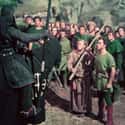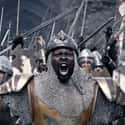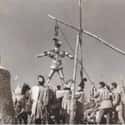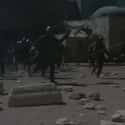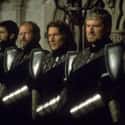-
(#12) Knights Thought Peasants Were Disposable
The Trope: Arrogant knights slay, injure, and victimize peasants without a second thought.
Why Is It Inaccurate?: Peasants certainly suffered under the politics, power struggles, and conflicts of the nobility. Indeed, knights sometimes offed peasants and generally looked down on them. But at the same time, disposing of peasants wouldn't have been in knights' best interest. Like other nobles, knights depended on peasants for income, whether through taxes or by working their land.
Notable Offenders: Modern adaptations of the Robin Hood story, including 1938's The Adventures of Robin Hood and 1991's Robin Hood: Prince of Thieves, emphasize tensions and inequalities between nobles and peasants. Monty Python and the Holy Grail satirizes the view of medieval peasants as filthy urchins.
-
(#5) Knights Only Wielded Heavy, Mighty Swords
The Trope: Whether carrying, wielding, or wearing it, a knight isn't a knight without a sword. Knights revered swords so much that they gave their tactical tools names.
Why Is It Inaccurate?: Knights really did value swords, especially since they were often status symbols, and some historical figures named their instruments, like Charlemagne's Joyeuse. Medieval swords weren't as heavy as most people imagine, though. After all, a sword that was too heavy to swing wouldn't be useful. Though they could be found in different varieties, a typical sword for conflict wouldn't weigh more than 10 pounds. Medieval knights also relied on a menu of tactical gear, including lances, axes, and daggers. In fact, lances and spears were usually the first tools knights would use on the battlefield. When Norman knights successfully infiltrated England in 1066, they wielded spears.
Notable Offenders: The trope of a knight and his sword has its roots in medieval literature. The 11th century's The Song of Roland, for instance, spotlights the relationship between a Frankish knight and Durendal, his divine sword. King Arthur's legendary sword, Excalibur, appears in Arthurian stories ranging from Sir Thomas Malory's 15th-century text Le Morte d'Arthur to 20th-century films like The Sword in the Stone and Excalibur.
-
(#3) Knights' Armor Was So Heavy That They Needed To Be Hoisted Onto Their Saddles With A Crane
The Trope: Armor weighed down knights so much that they couldn't lift themselves into their saddles. They had to rely on cranes to hoist them.
Why Is It Inaccurate?: If knights donned armor so heavy that they couldn't mount a horse, they wouldn't have made much of a fighting force. Knights' primary function was to fight on the battlefield; they needed to be agile. While armor added weight and sometimes required knights to expend more energy, knights trained to wear armor. The kind of armor knights used changed over time, ranging from relatively light chain mail, which would have weighed around 30 pounds, in the 11th and 12th centuries to plate armor in the 15th century. The heaviest armor was used for tournaments. The weight of armor aside, it would have been wildly impractical to rely on cranes and requisite manpower to hoist every single knight onto his steed before a clash.
Notable Offenders: One of the first films to wrongly portray knights relying on a crane to lift them up was Sir Laurence Olivier's Henry V from 1944.
-
(#6) Knights Discarded Their Shields In The Middle Of Combat
The Trope: A knight throws away his shield in the heat of a clash, presumably because it gets in the way of fighting.
Why Is It Inaccurate?: If a knight didn't want to hold the shield, he didn't have to throw it away - he could simply move it: Straps on shields ensured that knights could carry them on their backs. Since shields were important defensive tools that offered protection, discarding them would have been a terrible idea. But as armor offered more protection over time, shields became less necessary. By the end of the 1300s, shields bearing heraldic images were more often used in tournaments than on battlefields.
Notable Offenders: In the 2005 film Kingdom of Heaven, Balian - a knight in the Crusades - tosses aside his shield as he charges an enemy line during the siege of Jerusalem.
-
(#9) Knights Won't Do Anything That Opposes Their Code Of Chivalry
The Trope: Valorous knights always uphold a code of chivalry that requires them to act honorably and loyally in all that they do.
Why Is It Inaccurate?: The code of chivalry first emerged as a means of curbing and reforming ruthless and brutish warriors. As a code meant to shape the behavior of elites, chivalry encouraged knights to act ethically, honorably, and morally. But chivalry was more often an ideal rather than a reality. Warfare inherently demanded mayhem, and knights slayed innocents, like when Edward, Prince of Wales, laid siege to Limoges and massacred the city's residents. Knights sometimes committed sexual offenses, too, such as when the French noblewoman Marguerite de Carrouges accused the knight Jacques LeGris of forcing himself on her.
Notable Offenders: Medieval stories about knights - like Chrétien de Troyes's 12th-century text Lancelot, Or the Knight of the Cart - often centered on the tension between a knight's personal desires and his chivalric oath. Modern fiction takes up this mantle in series and films such as Knightfall, First Knight, Camelot, and Tristan and Isolde, which was based on a medieval story.
-
(#8) Knights Always Pledged Themselves To And Supported A Lord Or King
The Trope: The chivalrous knight is devoted to a liege lord and shows fidelity by protecting him, undertaking quests on his behalf, or enacting vengeance to honor his memory.
Why Is It Inaccurate?: Knights didn't always remain bound to a lord or king. Some knights belonged to independent religious orders, including the Knights Hospitaller or the Knights Templar. Others enlisted themselves to mercenary companies. Medieval knights sometimes rebelled against regal authority, such as when Sir Henry "Hotspur" Percy took up arms against King Henry IV of England in 1403.
Notable Offenses: Films, such as First Knight, Prince Valiant, Last Knights, and Ivanhoe, and television shows idealize the relationship between a knight and his liege lord.
New Random Displays Display All By Ranking
About This Tool
Speaking of the Middle Ages, many people always think of castles, banquets, churches, the Black Death, and poor peasants. However, the most exciting symbol of the Middle Ages may be the knight. These knights are often portrayed as heroes in movies or novels, wearing sharp swords and shiny armor. The great reason those medieval knights are respected is that they have always been the core on the battlefield before gunpowder was introduced to Europe, at least in legends and literary works.
This random tool shares the 13 most surprising facts about medieval knights to reveal the truth that most people don't know.
Our data comes from Ranker, If you want to participate in the ranking of items displayed on this page, please click here.











